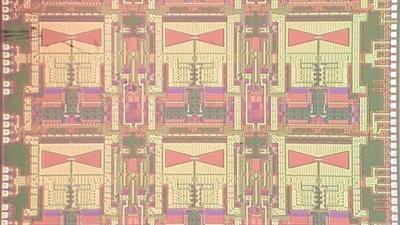
Radio-Frequency (Rf) Circuits And Systems - Basic Concepts
Published 11/2022
MP4 | Video: h264, 1280x720 | Audio: AAC, 44.1 KHz
Language: English | Size: 3.67 GB | Duration: 5h 42m
Basic Concepts[/center]
What you'll learn
This seven course series, for the first time ever, goes over the radio-frequency circuits and systems. All aspects of the RF design are covered in this course.
Due to its breath and depth, this course is decomposed into two parts. Part 1 covers basic concepts and system-level architectures. Part 2 covers RF circuits.
The students will acquire a deep and hands-on knowledge of RF circuits and systems.
This course delivers essential skillset that is needed for a job in a highly demand Semiconductor industry and especially the field of RFIC.
Requirements
The prerequisite for this course is to have a knowledge of analog electronic circuits and basic circuit theory
The second leg of this course may go through Cadence simulation of RF circuits
Description
Radio-frequency (RF) circuits and systems are ubiquitous parts of any electronic gadget and instrument that are widely used by the general public. RF design is often considered to be one of the most challenging areas in electrical engineering. This course series promises to deliver a comprehensive overview of RF circuits and systems. The first course covered in this series is primarily on basic concepts in RF design. Concepts such as linearity and noise will be presented and figure-of-merits to evaluate the linearity and noise performance of the RF systems will be introduced. Specifically, the course first goes over the basics of wireless transmitters and receivers. Next, the fundamental concept of power transfer in RF circuits will be briefly studied. This is followed by the analysis of large-signal behavior and the associated impairments such as gain compression and intermodulation. Next, device noise will be studied and ways of modeling the impact of various sources of noise in electronic circuits will be investigated and the concepts of noise figure and noise temperature will be introduced. Finally, the course will look at important performance parameters such as receiver sensitivity and dynamic range and study these parameters in terms of noise performance and distortion.
Overview
Section 1: Introduction
Lecture 1 Introduction
Section 2: Basic Concepts
Lecture 2 Basics of Wireless Radios: Up- and Down-Conversion, Unites in RF Design
Section 3: Basic Concepts in RF Circuits and Systems
Lecture 3 Maximum Power transfer Theorem; Power-Gain Definitions
Section 4: Basic Concepts in RF Circuits and Systems
Lecture 4 Linearity and Large-Signal Operation in RF Circuits and Systems - Outline
Section 5: Basic Concepts in RF Circuits and Systems
Lecture 5 Large-Signal Operation and Non-Linearity in RF Circuits
Section 6: Basic Concepts in RF Circuits and Systems
Lecture 6 Gain Compression Phenomenon
Section 7: Basic Concepts in RF Circuits and Systems
Lecture 7 Intermodulation Distortion
Section 8: Basic Concepts in RF Circuits and Systems
Lecture 8 Introducing the Concept of Third-Intercept Point (IP3)
Section 9: Basic Concepts in RF Circuits and Systems
Lecture 9 Intermodulation of Cascaded RF Systems and Analysis of IP2
Section 10: Basic Concepts in RF Circuits and Systems
Lecture 10 Effect of Feedback on Linearity of Large-Signal ERF Circuits
Section 11: Basic Concepts in RF Circuits and Systems
Lecture 11 Noise in RF Circuits and Systems - Outline
Section 12: Basic Concepts in RF Circuits and Systems
Lecture 12 Basics of Noise in Electronic Circuits
Section 13: Basic Concepts in RF Circuits and Systems
Lecture 13 Power Spectral Density of Random Process; White Noise; and Thermal Noise
Section 14: Basic Concepts in RF Circuits and Systems
Lecture 14 MOS Channel Thermal Noise and Flicker Noise
Section 15: Basic Concepts in RF Circuits and Systems
Lecture 15 Noise Analysis of a Simple Common-Source Amplifier Stage
Section 16: Basic Concepts in RF Circuits and Systems
Lecture 16 Noise Analysis in Basic Single-Stage MOS Amplifiers
Section 17: Basic Concepts in RF Circuits and Systems
Lecture 17 Two Examples: Noise Analyses of CMOS Inverter and Folded Cascode Amplifiers
Section 18: Basic Concepts in RF Circuits and Systems
Lecture 18 Noise Figure (NF); Noise Temperature; NF of Cascaded Systems
Section 19: Basic Concepts in RF Circuits and Systems
Lecture 19 Noise Figure of a Passive Network and a Basic Common-Gate Amplifier
Section 20: Basic Concepts in RF Circuits and Systems
Lecture 20 Noise Floor, RF Receiver Sensitivity, and SFDR Definitions
Section 21: Basic Concepts in RF Circuits and Systems
Lecture 21 Two Examples on the Linearity (P1dB and IP3) Analysis and Calculation
Section 22: Basic Concepts in RF Circuits and Systems
Lecture 22 Two Example on Sensitivity of a Receiver and Noise Power of a Lowpass Filter
This course is intended for electrical engineers, graduate students, senior-level undergraduate students
[align=center]
download скачать link
rapidgator.net:
https://rapidgator.net/file/56867ffe4056721d559e4bcda9630152/vngta.RadioFrequency.Rf.Circuits.And.Systems..Basic.Concepts.part1.rar.html https://rapidgator.net/file/26a23e4bff23d8234fe266c980f5bf2a/vngta.RadioFrequency.Rf.Circuits.And.Systems..Basic.Concepts.part2.rar.html https://rapidgator.net/file/2990fb59b3b06a47b515047dc990ef83/vngta.RadioFrequency.Rf.Circuits.And.Systems..Basic.Concepts.part3.rar.html https://rapidgator.net/file/e52f77622f71650a2c20025e3d653610/vngta.RadioFrequency.Rf.Circuits.And.Systems..Basic.Concepts.part4.rar.html
uploadgig.com:
https://uploadgig.com/file/download скачать/1F8c69150dF957f4/vngta.RadioFrequency.Rf.Circuits.And.Systems..Basic.Concepts.part1.rar https://uploadgig.com/file/download скачать/e8Bf7931B58db009/vngta.RadioFrequency.Rf.Circuits.And.Systems..Basic.Concepts.part2.rar https://uploadgig.com/file/download скачать/C9b2F473Ad3a815f/vngta.RadioFrequency.Rf.Circuits.And.Systems..Basic.Concepts.part3.rar https://uploadgig.com/file/download скачать/55495c4e179ba879/vngta.RadioFrequency.Rf.Circuits.And.Systems..Basic.Concepts.part4.rar
nitroflare.com:
https://nitroflare.com/view/02C322865DFB8F7/vngta.RadioFrequency.Rf.Circuits.And.Systems..Basic.Concepts.part1.rar https://nitroflare.com/view/A9212288B53EAD2/vngta.RadioFrequency.Rf.Circuits.And.Systems..Basic.Concepts.part2.rar https://nitroflare.com/view/D0C556C7F3E9B42/vngta.RadioFrequency.Rf.Circuits.And.Systems..Basic.Concepts.part3.rar https://nitroflare.com/view/4C8EE882B2181C6/vngta.RadioFrequency.Rf.Circuits.And.Systems..Basic.Concepts.part4.rar
1dl.net:
https://1dl.net/nh3dwakmq6je/vngta.RadioFrequency.Rf.Circuits.And.Systems..Basic.Concepts.part1.rar.html https://1dl.net/345r3mi7z7kd/vngta.RadioFrequency.Rf.Circuits.And.Systems..Basic.Concepts.part2.rar.html https://1dl.net/5fz8lfrapm6o/vngta.RadioFrequency.Rf.Circuits.And.Systems..Basic.Concepts.part3.rar.html https://1dl.net/wcyl9gti2kho/vngta.RadioFrequency.Rf.Circuits.And.Systems..Basic.Concepts.part4.rar.html

